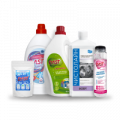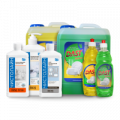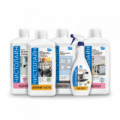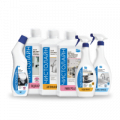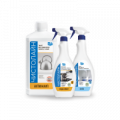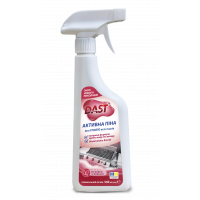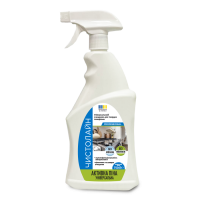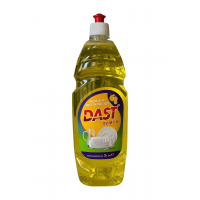How to care for modern cooktops? Products for glass-ceramic, induction, or gas stoves
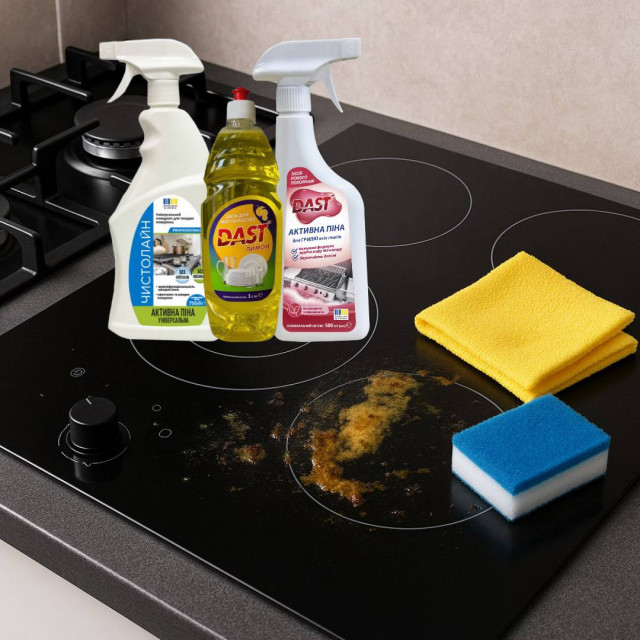
Content
Modern cooktops are an essential part of any 21st-century kitchen. They combine functionality with aesthetics and often set the tone for the entire cooking space. However, to maintain their appearance and performance over time, proper care is necessary. It’s not just about removing dirt — it’s about consistent, thoughtful hygiene based on the materials and type of cooktop. Let's explore how to care for electric stoves and examine the specific care instructions for ceramic, induction, gas, and electric cooktops. We'll also provide practical tips on preventing stains, choosing cleaning agents, and regular maintenance.
Types of Cooktops and Their Features
Before diving into cleaning techniques, it’s important to understand the differences between common types of cooktops — each requires a tailored approach:
-
Gas cooktops — equipped with burners, grates, and ignition systems. The base may be enamel, stainless steel, or tempered glass.
-
Electric cooktops — powered by heating elements (TENs), often covered with tempered glass or ceramic surfaces.
-
Induction cooktops — similar in appearance to electric ones, but heat is generated by magnetic induction. The surface itself does not get hot — only the cookware does.
-
Glass-ceramic cooktops — sleek and smooth, but require delicate care due to their sensitivity to scratches and thermal shock.
Understanding these features allows for not just surface cleaning, but safe and long-term use.
General Care Principles for Cooktops
While each type of cooktop has its own specifics, several universal rules apply regardless of model. These habits form the foundation for durability:
-
Regular cleaning: Wipe up messes right after the surface cools down. The longer grime sits, the harder it is to remove.
-
Cool before cleaning: Never start cleaning while the surface is hot — especially important for ceramic cooktops.
-
Use soft materials: Only use microfiber cloths or soft sponges to avoid scratching.
-
No abrasives or metal brushes: Even one use can damage the surface and void the warranty.
-
Use appropriate cleaners: Avoid universal or aggressive cleaners — use products specifically formulated for cooktops.
Following these basics significantly reduces wear and tear and makes daily care easier.
Caring for Glass-Ceramic Cooktops
If your kitchen features a glass-ceramic cooktop, gentle and frequent care is essential. These surfaces are prone to scratches, cloudiness, and mineral buildup. Key tips:
-
Clean food residue right after the surface cools down.
-
Use specialized creams or gels for glass-ceramic surfaces — they create a protective layer.
-
Avoid sugar, caramel, or plastic on hot surfaces — they melt and can permanently damage the glass.
-
Carefully remove burnt residues with a plastic scraper held at an angle.
-
Use a soft microfiber cloth and anti-static cleaners for final polishing.
Preventive measures matter too — don’t place cookware with dirty or uneven bottoms on the cooktop.
Caring for Induction Cooktops
Induction cooktops have a tough glass surface and don’t heat up themselves, minimizing burnt residue. Still, proper care is important:
-
Wipe with a damp soft cloth after each use.
-
Avoid harsh chemicals that contain alkalis or acids.
-
For grease, use non-abrasive specialized cleaners.
-
Always check cookware bottoms for cleanliness and flatness to prevent micro-scratches.
-
Never place a hot pan directly from a gas stove onto the induction surface — it could cause thermal shock.
Since induction cooktops only work when in contact with cookware, keeping the cookware clean also helps maintain the cooktop.
Caring for Gas Cooktops
Gas cooktops require more complex maintenance — not just the surface, but also the burners, grates, and knobs:
-
Remove and clean grates and burners at least once a week.
-
Soak parts in warm water with mild detergent to soften grease and buildup.
-
Metal parts can be cleaned with baking soda and vinegar — but carefully, to avoid damaging enamel. Preferably use professional cleaners.
-
Wipe the surface daily with a soft sponge and non-abrasive cleaner.
-
Clean ventilation ports and injectors carefully — a toothpick or needle can help, but always follow manufacturer instructions.
Improper care can clog injectors, reduce flame performance, or cause ignition issues — regular and attentive cleaning is essential.
Caring for Electric Cooktops
Electric cooktops come with exposed heating elements or a glass top. Care varies depending on the design:
-
If the cooktop has open elements, unplug it before cleaning.
-
Remove burnt food carefully without metal tools.
-
Never let water seep into the internal housing.
-
For glass surfaces, use the same cleaners as for ceramic cooktops.
Proper maintenance helps prevent overheating, reduced efficiency, and component failure.
What Cleaning Products Are Suitable for Cooktops?
Choosing the right cleaner is one of the most important factors in cooktop care. Even flawless technique won’t help if the chemical is too harsh. This is especially true for ceramic, induction, and glass surfaces. Here's a breakdown of safe and conditionally safe cleaners:
-
Chistoline Active Foam Cleaner: A gentle formula without harsh alkalis or abrasives makes this product suitable for cooktops — ideal for daily cleaning with proper rinsing. Great for glass and ceramic surfaces.
-
DAST Lemon Dishwashing Liquid: While designed for dishes, its mild composition (low acid and surfactant content, no abrasives) makes it safe for light cleaning of ceramic and induction surfaces. Also useful for glass cooktops.
-
DAST Grill Foam Cleaner: A powerful degreaser with alkalis and solvents, perfect for cast iron grates and metal burner parts — not recommended for glass or ceramic cooktops due to surface risk.
MDM Group products: Vary in intensity — some are ideal for delicate surfaces, others for deep cleaning of gas stove components. Always use as intended.
Stain Prevention: What You Can Do in Advance
Preventive cleaning is half the battle — it reduces cleaning effort and keeps the cooktop in perfect condition. Simple habits include:
-
Always wipe the bottom of pots and pans before placing them on the surface.
-
Use lids to prevent splatter and buildup.
-
Center cookware correctly on burners — prevents overheating and spills.
-
Don’t overheat oil or sugar — burnt stains are difficult to remove.
-
Use protective mats if your cooktop design allows it.
These simple steps help keep your cooktop clean and reduce the need for harsh scrubbing.
Conclusion: A Systematic Approach Is the Key to a Perfect Cooktop
Modern cooktops are advanced appliances that require thoughtful, consistent care — not aggressive cleaning. Always consider the type of surface, coating material, and manufacturer recommendations.
The main principles remain the same: gentle cleaning, proper cleaning products, and stain prevention. With the right care routine, your cooktop will retain its shine, performance, and reliability for years to come.
